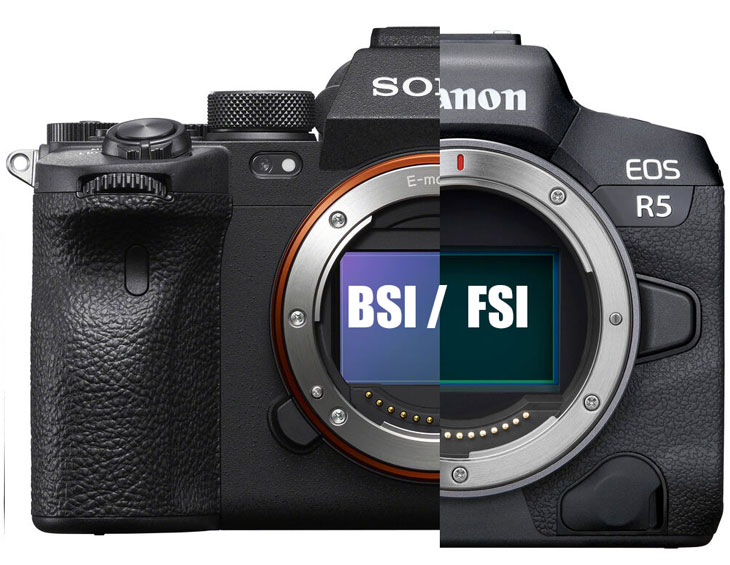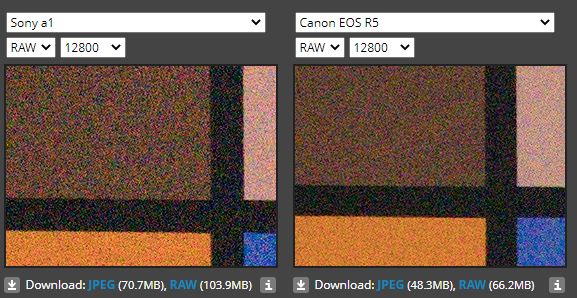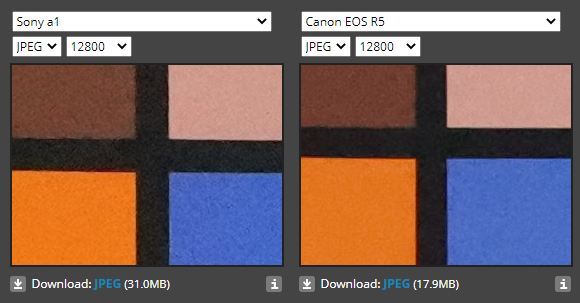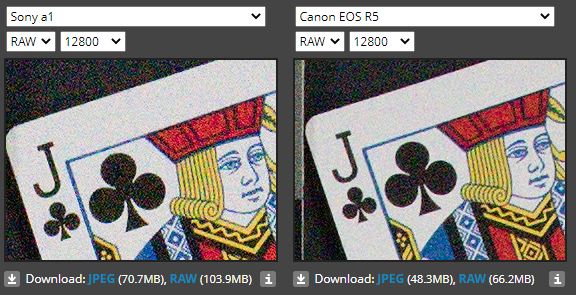
Dpreview published high ISO samples of Sony A1 camera recently. But I am really surprised to see the low-light comparison of Canon EOS R5 camera samples with the Sony A1. The noise level in Jpeg and RAW mode is almost the same.
Which one has a better sensor? Canon EOS R5 or Sony A1?
Technically Sony A1 carries a better sensor than of Canon EOS R5 camera. Since, the A1 features a back-illuminated sensor, also known as backside illumination (BSI or BI) and Canon ESO R5 uses FSI (front side illuminated).
- Canon EOS R5 – 45MP Full-Frame CMOS Sensor
- Sony A1 – 50MP Full-Frame Exmor RS BSI CMOS Sensor
Now, it’s time to see the image comparison of both the camera at a 100% scale
Sony A1 vs Canon EOS R5 @ ISO 12800 (RAW)

You can clearly see the color noise level of both the camera at ISO 12800. Canon EOS R5 conventional CMOS Sensor color noise is very well controlled.
Sony A1 vs Canon EOS R5 @ ISO 12800 (Jpeg)

Even in Jpeg files, you can clearly see how well Canon is restoring the overall image.

It’s really hard to believe we are comparing a conventional CMOS sensor with a BSI CMOS sensor. Do share your thoughts with us.
Also, see –
- Canon EOS R5 vs Sony A1 Specification comparison
- Sony A1 8k Sample Video
- Sony A1 Press Release, Full Specification and Price
- Sony A1 Sample Images
source –dpreview







Canon cheats with NR built-in to the RAW which cannot be turned off. Also if you use the low-light scene in the dpreview comparator the R5 is clearly worse. Not saying the R5 sensor isn’t good, because it is, but it still trails the Sony sensors in noise and DR. Wouldn’t stop me buying one however.
Seeing the comparison especially at low ISOS 100-800, it is clear that the 5,000,000 pixels of more than the a1, together with the revolutionary back-illuminated technology of its CMOS, make the detail or acuity look / appreciate a lot cleaner and more defined. Pity or rather, I do not understand that with the 100X100 competition engaged in the development of CMOS-BSI, Canon continues to evolve its CMOS of a lifetime. A whole X-file. The acuity of an image, _which depends on the optical quality used_, is the degree of contrast observed at the border between details that differ due to their luminance. The more contrasted the boundary between a dark area and a lighter one, the greater the acuity and with it the sharpness perceived in the image.
Viendo la comparativa sobre todo a ISOS bajos 100-800, está claro que los 5.000.000 de pixeles de más de la a1, junto a la revolucionaria tecnología retro iluminada de su CMOS, hacen que el detalle o acutancia se vea / se aprecie mucho más limpio y definido. Lástima o mejor dicho, no entiendo que con la competencia 100X100 comprometida en el desarrollo del CMOS-BSI, Canon siga evolucionando sus CMOS de toda la vida. Todo un expediente X.
La acutancia de una imagen, _que depende si o si de la calidad óptica utilizada_, es el grado de contraste que se observa en el límite entre detalles que difieren por su luminancia. Cuanto más contrastado sea el límite entre una zona oscura y otra más clara, mayor es la acutancia y con ella la nitidez percibida en la imagen.
Well… This is just half of the story… Just do -3 EV and try to restore the shadows… And you will see that canon is decade behind… With lenses and with the sensors.